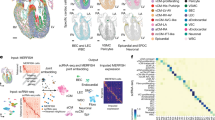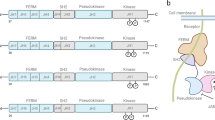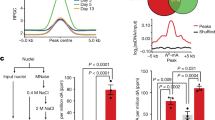Abstract
Fibrogenesis is a pathological wound repair process that fails to cease, even when the initial insult has been removed. Fibroblasts are principal mediators of fibrosis, and fibroblasts from fibrotic tissues fail to return to their quiescent stage, including when cultured in vitro. In a search for underlying molecular mechanisms, we hypothesized that this perpetuation of fibrogenesis is caused by epigenetic modifications. We demonstrate here that hypermethylation of RASAL1, encoding an inhibitor of the Ras oncoprotein, is associated with the perpetuation of fibroblast activation and fibrogenesis in the kidney. RASAL1 hypermethylation is mediated by the methyltransferase Dnmt1 in renal fibrogenesis, and kidney fibrosis is ameliorated in Dnmt1+/− heterozygous mice. These studies demonstrate that epigenetic modifications may provide a molecular basis for perpetuated fibroblast activation and fibrogenesis in the kidney.
This is a preview of subscription content, access via your institution
Access options
Subscribe to this journal
Receive 12 print issues and online access
$209.00 per year
only $17.42 per issue
Buy this article
- Purchase on Springer Link
- Instant access to full article PDF
Prices may be subject to local taxes which are calculated during checkout






Similar content being viewed by others
References
Eddy, A.A. Molecular insights into renal interstitial fibrosis. J. Am. Soc. Nephrol. 7, 2495–2508 (1996).
Kuncio, G.S., Neilson, E.G. & Haverty, T. Mechanisms of tubulointerstitial fibrosis. Kidney Int. 39, 550–556 (1991).
Strutz, F. & Zeisberg, M. Renal fibroblasts and myofibroblasts in chronic kidney disease. J. Am. Soc. Nephrol. 17, 2992–2998 (2006).
Kalluri, R. & Zeisberg, M. Fibroblasts in cancer. Nat. Rev. Cancer 6, 392–401 (2006).
Müller, G.A. & Rodemann, H.P. Characterization of human renal fibroblasts in health and disease: I. Immunophenotyping of cultured tubular epithelial cells and fibroblasts derived from kidneys with histologically proven interstitial fibrosis. Am. J. Kidney Dis. 17, 680–683 (1991).
Rodemann, H.P. & Müller, G.A. Characterization of human renal fibroblasts in health and disease: II. In vitro growth, differentiation, and collagen synthesis of fibroblasts from kidneys with interstitial fibrosis. Am. J. Kidney Dis. 17, 684–686 (1991).
Weber, K.T. & Brilla, C.G. Factors associated with reactive and reparative fibrosis of the myocardium. Basic Res. Cardiol. 87, Suppl 1, 291–301 (1992).
Hinz, B. et al. The myofibroblast: one function, multiple origins. Am. J. Pathol. 170, 1807–1816 (2007).
Lafyatis, R. Targeting fibrosis in systemic sclerosis. Endocr. Metab. Immune Disord. Drug Targets 6, 395–400 (2006).
Lin, J. et al. Kielin/chordin-like protein, a novel enhancer of BMP signaling, attenuates renal fibrotic disease. Nat. Med. 11, 387–393 (2005).
Santini, V., Kantarjian, H.M. & Issa, J.P. Changes in DNA methylation in neoplasia: pathophysiology and therapeutic implications. Ann. Intern. Med. 134, 573–586 (2001).
Bird, A.P. & Wolffe, A.P. Methylation-induced repression—belts, braces, and chromatin. Cell 99, 451–454 (1999).
Feinberg, A.P. & Vogelstein, B. Alterations in DNA methylation in human colon neoplasia. Semin. Surg. Oncol. 3, 149–151 (1987).
Herman, J.G. & Baylin, S.B. Gene silencing in cancer in association with promoter hypermethylation. N. Engl. J. Med. 349, 2042–2054 (2003).
Jones, P.A. & Baylin, S.B. The epigenomics of cancer. Cell 128, 683–692 (2007).
Clark, S.J., Statham, A., Stirzaker, C., Molloy, P.L. & Frommer, M. DNA methylation: bisulphite modification and analysis. Nat. Protoc. 1, 2353–2364 (2006).
Gius, D. et al. The epigenome as a molecular marker and target. Cancer 104, 1789–1793 (2005).
Downward, J. Targeting RAS signalling pathways in cancer therapy. Nat. Rev. Cancer 3, 11–22 (2003).
Mitin, N., Rossman, K.L. & Der, C.J. Signaling interplay in Ras superfamily function. Curr. Biol. 15, R563–R574 (2005).
Walker, S.A. et al. Identification of a Ras GTPase-activating protein regulated by receptor-mediated Ca2+ oscillations. EMBO J. 23, 1749–1760 (2004).
Barbacid, M. Ras genes. Annu. Rev. Biochem. 56, 779–827 (1987).
Bos, J.L. Ras oncogenes in human cancer: a review. Cancer Res. 49, 4682–4689 (1989).
Arun, D. & Gutmann, D.H. Recent advances in neurofibromatosis type 1. Curr. Opin. Neurol. 17, 101–105 (2004).
Kolfschoten, I.G. et al. A genetic screen identifies PITX1 as a suppressor of RAS activity and tumorigenicity. Cell 121, 849–858 (2005).
Jin, H. et al. Epigenetic silencing of a Ca2+-regulated Ras GTPase-activating protein RASAL defines a new mechanism of Ras activation in human cancers. Proc. Natl. Acad. Sci. USA 104, 12353–12358 (2007).
Gazin, C., Wajapeyee, N., Gobeil, S., Virbasius, C.M. & Green, M.R. An elaborate pathway required for Ras-mediated epigenetic silencing. Nature 449, 1073–1077 (2007).
Lloyd, C.M. et al. RANTES and monocyte chemoattractant protein-1 (MCP-1) play an important role in the inflammatory phase of crescentic nephritis, but only MCP-1 is involved in crescent formation and interstitial fibrosis. J. Exp. Med. 185, 1371–1380 (1997).
Zeisberg, M. et al. BMP-7 counteracts TGF-β1–induced epithelial-to-mesenchymal transition and reverses chronic renal injury. Nat. Med. 9, 964–968 (2003).
Witzgall, R., Brown, D., Schwarz, C. & Bonventre, J.V. Localization of proliferating cell nuclear antigen, vimentin, c-Fos and clusterin in the postischemic kidney. Evidence for a heterogenous genetic response among nephron segments, and a large pool of mitotically active and dedifferentiated cells. J. Clin. Invest. 93, 2175–2188 (1994).
Oliver, J.A., Maarouf, O., Cheema, F.H., Martens, T.P. & Al-Awqati, Q. The renal papilla is a niche for adult kidney stem cells. J. Clin. Invest. 114, 795–804 (2004).
Hendry, B.M. & Sharpe, C.C. Targeting Ras genes in kidney disease. Nephron 93, e129–e133 (2003).
Li, E., Beard, C. & Jaenisch, R. Role for DNA methylation in genomic imprinting. Nature 366, 362–365 (1993).
Okano, M., Bell, D.W., Haber, D.A. & Li, E. DNA methyltransferases Dnmt3a and Dnmt3b are essential for de novo methylation and mammalian development. Cell 99, 247–257 (1999).
Li, E., Bestor, T.H. & Jaenisch, R. Targeted mutation of the DNA methyltransferase gene results in embryonic lethality. Cell 69, 915–926 (1992).
Bottinger, E.P. & Bitzer, M. TGF-β signaling in renal disease. J. Am. Soc. Nephrol. 13, 2600–2610 (2002).
Border, W.A. & Noble, N.A. Targeting TGF-β for treatment of disease. Nat. Med. 1, 1000–1001 (1995).
Strutz, F. et al. TGF-β1 induces proliferation in human renal fibroblasts via induction of basic fibroblast growth factor (FGF-2). Kidney Int. 59, 579–592 (2001).
Basile, D.P. et al. Identification of persistently altered gene expression in the kidney after functional recovery from ischemic acute renal failure. Am. J. Physiol. Renal Physiol. 288, F953–F963 (2005).
Forbes, J.M., Leaker, B., Hewitson, T.D., Becker, G.J. & Jones, C.L. Macrophage and myofibroblast involvement in ischemic acute renal failure is attenuated by endothelin receptor antagonists. Kidney Int. 55, 198–208 (1999).
Villanueva, S., Cespedes, C. & Vio, C.P. Ischemic acute renal failure induces the expression of a wide range of nephrogenic proteins. Am. J. Physiol. Regul. Integr. Comp. Physiol. 290, R861–R870 (2006).
Ding, M. et al. Loss of the tumor suppressor Vhlh leads to upregulation of Cxcr4 and rapidly progressive glomerulonephritis in mice. Nat. Med. 12, 1081–1087 (2006).
Rothenpieler, U.W. & Dressler, G.R. Pax-2 is required for mesenchyme-to-epithelium conversion during kidney development. Development 119, 711–720 (1993).
Khwaja, A., Sharpe, C.C., Noor, M., Kloog, Y. & Hendry, B.M. The inhibition of human mesangial cell proliferation by S-trans, trans-farnesylthiosalicylic acid. Kidney Int. 68, 474–486 (2005).
Zaidi, N. et al. A new approach for distinguishing cathepsin E and D activity in antigen-processing organelles. FEBS J. 274, 3138–3149 (2007).
Zeisberg, E.M. et al. Endothelial-to-mesenchymal transition contributes to cardiac fibrosis. Nat. Med. 13, 952–961 (2007).
Zeisberg, E.M., Potenta, S.E., Sugimoto, H., Zeisberg, M. & Kalluri, R. Fibroblasts in kidney fibrosis emerge via endothelial-to-mesenchymal transition. J. Am. Soc. Nephrol. 19, 2282–2287 (2008).
Chatterjee, P.K. et al. Calpain inhibitor-1 reduces renal ischemia/reperfusion injury in the rat. Kidney Int. 59, 2073–2083 (2001).
Acknowledgements
This study was partially funded by research grants R01DK081576 (M.Z.), R03DK081687 (M.Z.), R01DK30932 (D.J.S.), R01DK55001 (R.K.), R01CA125550 (R.K.), Mentored Clinical Scientist Development Awards 1K08 CA129204 (E.M.Z.) and K08 DK074558 (M.Z.) from the National Institutes of Health, the American Society of Nephrology Carl W. Gottschalk Scholar Grant (M.Z.), American Heart Association Scientist Development Grant SDG0735602T, Deutsche Forschungsgemeinschaft-Stipendium BE4211/1-1 (W.B.), Champalimaud Metastasis Research Program (R.K.) and research funds from the Beth Israel Deaconess Medical Center for the Division of Matrix Biology. We thank A. Lau and T. Zhong Hu for technical assistance. FSP-1–specific antibodies were a gift from E. Neilson (Vanderbilt University).
Author information
Authors and Affiliations
Contributions
W.B. performed and designed experiments, analyzed data and edited the manuscript. S.M. performed experiments and analyzed data. E.M.Z. advised, performed experiments, analyzed data and edited the manuscript. G.A.M. and C.A.M. characterized and provided human fibroblasts. H.K. generated Rasal1 antibodies. D.J.S. provided nephrotoxic serum and edited the manuscript. R.K. advised and edited the manuscript. M.Z. designed, performed and supervised experiments, analyzed data and wrote the manuscript.
Corresponding author
Ethics declarations
Competing interests
The authors declare no competing financial interests.
Supplementary information
Supplementary Text and Figures
Supplementary Figures 1–9 and Supplementary Tables 1–3 (PDF 2376 kb)
Rights and permissions
About this article
Cite this article
Bechtel, W., McGoohan, S., Zeisberg, E. et al. Methylation determines fibroblast activation and fibrogenesis in the kidney. Nat Med 16, 544–550 (2010). https://doi.org/10.1038/nm.2135
Received:
Accepted:
Published:
Issue Date:
DOI: https://doi.org/10.1038/nm.2135
This article is cited by
-
Fibroblast and myofibroblast activation in normal tissue repair and fibrosis
Nature Reviews Molecular Cell Biology (2024)
-
Epigenetics as a versatile regulator of fibrosis
Journal of Translational Medicine (2023)
-
Cancer-associated fibroblast-derived exosome microRNA-21 promotes angiogenesis in multiple myeloma
Scientific Reports (2023)
-
The importance of being CAFs (in cancer resistance to targeted therapies)
Journal of Experimental & Clinical Cancer Research (2022)
-
Methyl-CpG-binding domain protein 2 contributes to renal fibrosis through promoting polarized M1 macrophages
Cell Death & Disease (2022)



